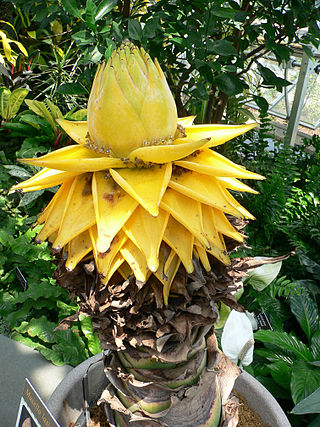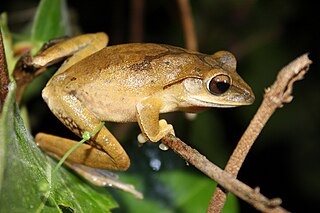
Primula is a genus of herbaceous flowering plants in the family Primulaceae. They include the primrose, a familiar wildflower of banks and verges. Other common species are P. auricula (auricula), P. veris (cowslip), and P. elatior (oxlip). These species and many others are valued for their ornamental flowers. They have been extensively cultivated and hybridised. Primula are native to the temperate Northern Hemisphere, south into tropical mountains in Ethiopia, Indonesia, and New Guinea, and in temperate southern South America. Almost half of the known species are from the Himalayas.

Cyprinus is the genus of typical carps in family Cyprinidae. Most species in the genus are of East Asia origin with only the common carp in Western Asia and Europe; this invasive species has also been introduced to many other regions around the world. Cyprinus are closely related to some more barb-like genera, such as Cyclocheilichthys and Barbonymus (tinfoils). The crucian carps (Carassius) of western Eurasia, which include the goldfish, are apparently not as closely related.

Dianchi Lake, also known as Lake Dian and Kunming Lake, is a large lake located on the Yunnan-Guizhou Plateau close to Kunming, Yunnan, China. Its nickname is the "Sparkling Pearl Embedded in a Highland" and it was the model for the Kunming Lake in the Summer Palace in Beijing. Its name is the source of Yunnan's Chinese abbreviation 滇.

Yilong Lake is a large freshwater lake located in Shiping County, Honghe Prefecture, Yunnan province, southwestern China. The lake has a surface area of approximately 32 square kilometres (12 sq mi) and is particularly notable for its scenery, including the colorful lotus flowers that bloom on its surface. It is located about 2 kilometres (1.2 mi) east of the county seat. The people who live in the vicinity of the lake are largely of the Yi ethnic group. As of the spring of 2013 a severe drought had resulted in substantial lowering of the water level.

Musella lasiocarpa, commonly known as Chinese dwarf banana, golden lotus banana or Chinese yellow banana, is the sole species in the genus Musella. It is thus a close relative of bananas, and also a member of the family Musaceae.

Polypedates megacephalus, the Hong Kong whipping frog or spot-legged tree frog, is a species in the shrub frog family (Rhacophoridae). In its native range, it is also called "brown tree frog", but this name is otherwise applied to a species of the true tree frog family (Hylidae).
The Yulungshan vole, Yulong Chinese vole, Yulongxuen Chinese vole, or Yulongxuen red-backed vole is a species of rodent in the family Cricetidae, endemic to Jade Dragon Snow Mountain in the Sichuan–Yunnan border region of China.
Nidirana lini is a species of frog in the family Ranidae. It is known with some certainty from southern Yunnan (China), Laos, Thailand, and north-western Vietnam. It has been mixed with Nidirana adenopleura and Nidirana chapaensis; its exact distribution is unclear, in particular whether populations referred to as N. adenopleura in southern China to Zhejiang in the east belong to this species.

Kurixalus naso, also known as uphill tree frog, long-snouted treefrog, and Annandale's high altitude frog, is a species of frog in the family Rhacophoridae. It is found in northeastern India, southern Tibet, and Bhutan. A related but unnamed species is found in Myanmar and Yunnan (China). Furthermore, it is possible that Kurixalus yangi is a junior synonym of Kurixalus naso.

The Yunnan hare is a medium-sized species of mammal in the family Leporidae. It has soft, flat, and long dorsal pelage which is grayish brown or dark gray in color, and whitish ventral pelage. It was considered endemic to China, but its presence was recorded in northern Myanmar in 2000. It is a herbivore, and forages on shrubs and forbs. It is rated as a species of least concern on the IUCN Red List of Endangered Species. The Red List of China's Vertebrates has listed the Yunnan hare as near threatened, almost meeting the criteria to be listed as vulnerable.

Musa basjoo, known variously as Japanese banana, Japanese fibre banana or hardy banana, is a species of flowering plant belonging to the banana family Musaceae. It was previously thought to have originated in the Ryukyu islands of southern Japan, from where it was first described in cultivation, but is now known to have originated in subtropical southern China, where it is also widely cultivated, with wild populations found in Sichuan province. Its specific name is derived from its Japanese common name, bashō (芭蕉).

An endangered species is a species that is very likely to become extinct in the near future, either worldwide or in a particular political jurisdiction. Endangered species may be at risk due to factors such as habitat loss, poaching, and invasive species. The International Union for Conservation of Nature (IUCN) Red List lists the global conservation status of many species, and various other agencies assess the status of species within particular areas. Many nations have laws that protect conservation-reliant species which, for example, forbid hunting, restrict land development, or create protected areas. Some endangered species are the target of extensive conservation efforts such as captive breeding and habitat restoration.

Fuxian Lake stretches out through Chengjiang, Jiangchuan and Huaning Counties in Yunnan Province, spanning an area of 212 square kilometers. The lake is ranked third-largest in Yunnan, after Dian Lake and Erhai Lake. The deepest lake in Yunnan, it is 155 meters deep at its greatest depth. It is also the third-deepest fresh water lake in China, after Tianchi and Kanas Lake.

Musa itinerans, the Yunnan banana, is a species of banana found in continental Southeast Asia from Northeast India to Vietnam. The tender inner stalk is also harvested and eaten. It is the landmark 24,200th plant species saved at Kew Gardens' Millennium Seed Bank Project. With this addition, the seed bank had collected 10% of the world’s wild plant species. In China it is an important food for wild Asian elephants.
Musa zaifui is a species of plant in the banana family native to temperate China.

Musa coccinea, commonly known as scarlet banana or red-flowering banana, is a species of flowering plant in the banana and plantain family Musaceae, native to tropical China and Vietnam. It is a bat-pollinated evergreen perennial, placed in section Callimusa, having a diploid chromosome number of 2n = 20.
Musa chunii is a species of wild banana, native from Arunachal Pradesh to western Yunnan in China. It is placed in section Musa, having a diploid chromosome number of 2n = 20.
Polypedates impresus is a species of frogs in the family Rhacophoridae. It is endemic to Yunnan, China, where it has been recorded in Pu'er. It is known from Yunnan and Guangxi. People have seen it between 600 and 1000 meters above sea level.

The Indochinese shrew is a species of white-toothed shrew native to Southeast Asia. It was first identified in 1922 by Herbert C. Robinson and C. Boden Kloss. The species is often taxonomized as a subspecies Horsfield's shrew, but bears a different range, occurring in Myanmar, Vietnam, and the Yunnan province of China.














